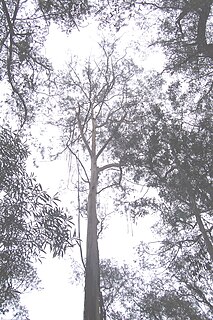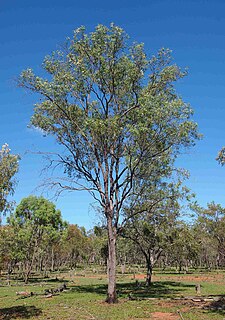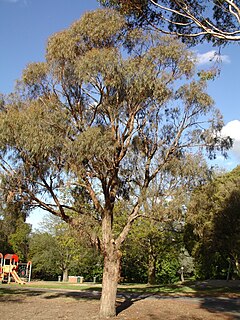
Eucalyptus dives or broad-leaved peppermint is a small tree native to temperate dry sclerophyll woodlands and forests of south-eastern Australia. The juvenile leaves are ovate and glaucous, and adult leaves are lanceolate to broad-lanceolate. Leaves are aromatic.

Eucalyptus piperita, commonly known as Sydney peppermint and urn-fruited peppermint, is a small to medium forest tree native to New South Wales, Australia.

Eucalyptus elata, River peppermint, River white gum, is a medium to tall tree with rough bark on the lower trunk, compact with narrow longitudinal fissures, dark grey, shedding above in long ribbons, often remaining in the crown, to leave a smooth, grey, cream or whitish surface.

Eucalyptus smithii, commonly known as the gully gum, gully peppermint or blackbutt peppermint,is a native tree of northern Victoria and southern New South Wales, Australia. It naturally occurs on the forested tablelands, lower slopes, gullies, and swamps, generally where the soil does not dry out.
Eucalyptus odorata is a small to medium evergreen Eucalyptus tree native to South Australia, Victoria and New South Wales. It is commonly known as Peppermint Box, Box Gum and Black Mallee.

Eucalyptus oreades, commonly known as the Blue Mountains ash, is a species of eucalyptus native to eastern Australia.
Eucalyptus nitida, commonly known as the Smithton Peppermint, is a eucalypt which is native to eastern Australia. In southwest Tasmania it is often seen growing in thickets along the backs of rivers and in the floors of valleys amidst environments otherwise dominated by heathland. It was first described by Joseph Dalton Hooker in 1856.

Eucalyptus amygdalina, or black peppermint, is a species of Eucalyptus which is endemic to Tasmania, Australia. It was first described by Labillardiere in 1806. It is one of the most common eucalypts in the state, where it is often a tree in sclerophyll forest or a shrub in open scrub and heath. It is known to integrate with E. nitida and E. pulchella.
Eucalyptus porosa is a species of eucalypt or gum tree, native to southern Australia. Common names include Water Mallee, Black Mallee, Black Mallee-box, Quorn Mallee, Peppermint Box, Whipstick Peppermint and South Australian Mallee Box.

Persoonia myrtilloides, commonly known as myrtle geebung, is a shrub species that is endemic to New South Wales in Australia. It grows to between 0.5 and 2.5 metres in height and has leaves that are between 12 and 50 millimetres long and 4 to 30 millimetres wide. Yellow flowers appear between December and April in the species native range.

The Burrinjuck Nature Reserve is a protected nature reserve on the south west slopes of New South Wales, Australia. The 5,250-hectare (13,000-acre) reserve is located adjacent to the Burrinjuck Dam, with 5,118 hectares of the reserve located on the northern side of the reservoir, and the remaining 89 hectares located on the southern side of the reservoir to the northeast of Black Andrew Nature Reserve. It includes land formerly managed as the Burrinjuck State Forest and Burrinjuck State Recreation Area.

The Black Andrew Nature Reserve is a protected nature reserve located on the south west slopes of New South Wales, Australia. The 1,559-hectare (3,850-acre) reserve is situated on the southern shore of Burrinjuck Dam on the Murrumbidgee River, an important reservoir for the Murrumbidgee Irrigation Area.
Eucalyptus croajingolensis, commonly known as the East Gippsland peppermint, is a tree native to New South Wales and Victoria in southeastern Australia.

Eucalyptus exserta, commonly known as Queensland peppermint, peppermint, bendo, yellow messmate or messmate, is a tree native to New South Wales and Queensland in eastern Australia.
Eucalyptus falciformis, commonly known as the Grampians peppermint, shining peppermint or western peppermint, is a mallee that is native to south eastern Australia.
Eucalyptus cajuputea, commonly known as the narrow-leaved peppermint box, is a tree or a mallee that is endemic to South Australia. It usually has rough, flaky bark on the trunk, linear to narrow lance-shaped adult leaves, flower buds arranged in groups of seven to eleven, white flowers and smooth, cup-shaped to barrel-shaped fruit.

East Risdon State Reserve is a IUCN Category II protected area on the eastern shore of the Derwent River in Clarence City, Hobart, Tasmania. It takes its name from the nearby suburb of Risdon.










